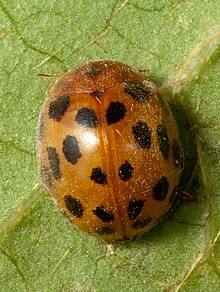Subcoccinella
| 24-spot Ladybird | |
|---|---|
 |
|
| Scientific classification | |
| Kingdom: | Animalia |
| Phylum: | Arthropoda |
| Class: | Insecta |
| Order: | Coleoptera |
| Family: | Coccinellidae |
| Subfamily: | Epilachninae |
| Genus: | Subcoccinella |
| Species: | S. vigintiquatuorpunctata |
| Binomial name | |
|
Subcoccinella vigintiquatuorpunctata (Linnaeus, 1758) |
|
| Synonyms | |
|
Coccinella vigintiquatuorpunctata |
|
Coccinella vigintiquatuorpunctata
Coccinella vigintiquinquepunctata
Subcoccinella 24-punctata
Subcoccinella vigintiquattuorpunctata
Subcoccinella vigintiquatuorpunctata (the 24-spot ladybird) is a beetle in the family Coccinellidae. It is the only member of the genus Subcoccinella. It has the typical, almost semi-spherical, ladybird shape and is patterned with spots. However it differs from many of the well-known ladybirds in being neither smooth and shiny nor an eater of aphids: the wing-cases look velvety and it eats fungal moulds on plants.
The common names for this insect in many languages follow the binomial name and mention that it has twenty-four spots, but in English there is great variation in how this is written, with little consensus over the use of words or numerals, capitalisation, placement of hyphens and whether to use "spot", "spotted", "point" or "pointed"; "ladybird", "ladybird beetle" or "ladybug". There is even disagreement about the spelling of the Latin "vigintiquatuorpunctata" with some authoritative UK lists preferring a double "t": "vigintiquattuopunctata". For ease it is often written "Subcoccinella 24-punctata". Given the multitude of name formations, it is probably best to use just the genus "Subcoccinella" when carrying out a web search for information about this insect to avoid missing texts that use variant spellings - it's the only species in the genus. In the US it is also known as the "Alfalfa Lady Beetle", though rarely found on alfalfa in North America.
The adult 24-spot is a small ladybird, usually 3 to 4 mm long. It has the quintessential ladybird shape, quite domed with the sides forming a smooth curve from head to pronotum to wing-cases. The wing-cases are covered with short pale hairs, and though these are hard to see without a hand lens, they give the ladybird a distinctive matt appearance. The ladybird is dark orange, including legs and antennae. There are black spots on the wing cases. These vary in number and size but there are often about 20 to 24 and usually no more than 26. Sometimes spots are joined together or they can be absent completely. Dark (melanic) forms are very rare. Another extremely rare form has yellow spots.
Larvae are 4 to 6mm long and pale grey-green with darker speckles. They are covered with branched spines. These spines are also present in the pupa, enabling the pupa to secrete noxious alkaloids as a defence against predators.
There are five European species in the Epilachninae subfamily, all herbivorous and somewhat hairy. The 24-spot Ladybird can be distinguished from the similarly patterned Bryony Ladybird - Henosepilachna argus (6 to 8 mm) by its small size (3 to 4 mm).Cynegetis impunctata, another small ladybird, is browner and has no spots. It also has a black head and this separates it from the form of the 24-spot Ladybird without spots.
...
Wikipedia
